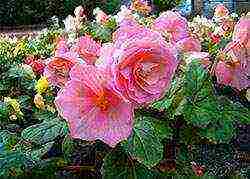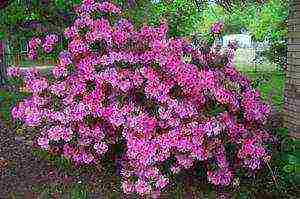Content
- 1 What kind of plant is a violet?
- 2 Varieties of violets
- 3 Rare violet
- 4 Growing conditions
- 5 Annuals
- 6 Perennial varieties of violets
- 7 Using garden violets in home design
- 8 Garden violet in urban landscape
- 9 Planting and breeding violets
- 10 Sowing violet seeds
- 11 Violet care
- 12 Pests and diseases
- 13 Brief description of the species
- 14 How to grow a perennial garden violet
- 15 Caring for a horned violet in the garden
- 16 Horned violet in landscape design
The pansy flower, scientifically - a garden violet, is an adornment of every flower bed where it is planted. Caring for this plant is simple and accessible to any beginner in floriculture. And what a variety of tones and shades! Previously, only lilac-violet gamut prevailed, which is where the name came from. Modern garden violets will bloom the flower bed in reds, blues, purples, yellows, pinks, orange and even white colors. If you want something special, then the velvet black flower petals will definitely attract attention.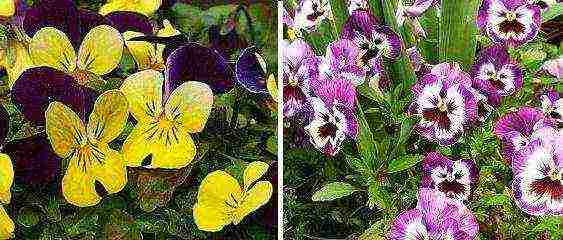
What kind of plant is a violet?
The name of this flower comes from the old Roman "viola" and was used in the creations of Pliny and Virgil. The garden violet, a photo of the varieties of which are presented in this article, is the oldest garden culture. Two millennia ago, the Romans and Greeks used it in wreaths to decorate rooms.
At the end of the eighteenth century, a botanist from Russia P. S. Pallas, who studied the Altai flora, brought this flower from Altai to St. Petersburg for the first time.
Violets are herbaceous one-, two- or perennial plants. Leaves are arranged in turn or collected in a basal rosette. The flowers are solitary, the upper petals are smaller than the lower ones, have a horn-shaped outgrowth or saccular at the base. The violet fruit is a capsule, the seeds retain the ability to germinate up to two years.
The genus of this plant has about 500 species that have spread throughout the world. There are both wild and cultivated species.
Varieties of violets
Many amateur gardeners grow violets of garden varieties in their flower beds, most often biennial or annual plants. A characteristic feature of such varieties is that they bloom in early spring and sink into the snow with flowers. Better than others of this species, the Vittrock violet has taken root in Russia.
But there is another species - perennial garden violet. She is quite capable of decorating a flower garden or flower bed for many years. But perennial garden violets delight the look with generous and luxurious flowering only in spring, since in summer they lose their decorative effect due to the formation of many seed bolls. A procedure such as pulling out wilted flowers in time will help lengthen the flowering period. Usually, fragrant violets and horned violets are grown as perennials.
Rare violet
It is worth noting a rare perennial variety of this plant. This is a white garden violet. In nature, it grows in forest glades, forest edges or in steppe meadows.
This is a beautiful small plant up to 12 cm high, the rosettes of the leaves look like a triangular heart. The flowers have a characteristic fragrant aroma. White violet can reproduce vegetatively or by seeds that are in a capsule, in a hairy ovary.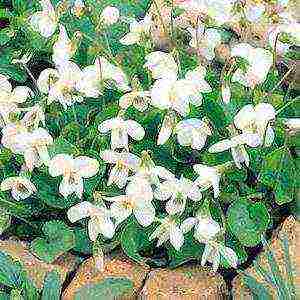
The violet blooms from March to May, and bears fruit from May to July. It grows in Podillia, Ukraine (in Transcarpathia) and here and there in the Crimea.
The problem with this species is that the white garden violet (photo above) disappears.This happens because steppe and meadow slopes are plowed up, shrub thickets are being destroyed, and natural conditions are changing. And since the populations of the white violet are mostly isolated, its resettlement to other zones is difficult.
Populations of white violets are restored under special conditions - in botanical gardens - and are under protection.
Growing conditions
The garden violet prefers sunny or slightly shaded areas that have fertile, well-drained soil. In dry weather, the plant needs watering, otherwise the flowers become smaller and flowering may stop altogether.
Despite the fact that violets are moisture-loving plants, they cannot tolerate excess moisture and can simply die during the period of spring thaws.
This plant easily tolerates light shading or diffused light, but the formation of many flowers and abundant flowering is possible only in a well-lit area. In places that are hidden from the sun and prone to dampness, the violet can be spoiled by slugs.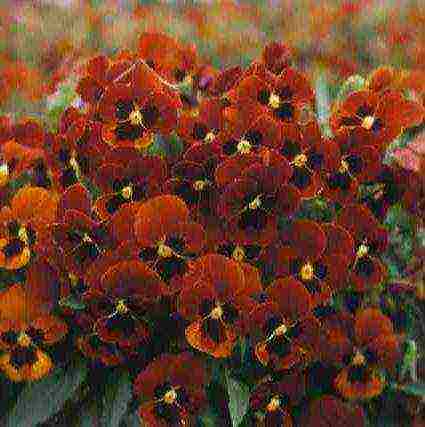
Perennial garden violet more and more wins the souls of flower growers. Only grow it as an annual or biennial. For the most part, this is due to the fact that over time, the stems of the violet are very elongated, and the flowers are reduced in size. It is obvious to everyone that it is easier and faster to plant new plants.
Annuals
The root system of annual violets is fibrous, that is, there is no main root, but there are a great many small roots. They penetrate the top layer of the soil with a wide network and do not go deep into it. Branched stems, on each branch usually several flowers open. The flowers of the annual are very large, reaching 10 cm. The annual garden violet is a neat decorative shrub up to 20 cm in height.
The most popular are the following types of peers:
- Chalon Supreme is a series of varieties with ruffled seven-centimeter flowers of extraordinary beauty.
- Rose Shades is a variety with pale pink petals and a purple center spot.
- Cherry Pie Mix - purple or maroon flowers with a white border.
- Flame is a variety with fiery red flowers bordered with orange edging.
- Cats is an interesting series of strains. It differs in that in the center of the flower you can see a pattern similar to a cat's face.
- Jema is a series specially designed for hot regions.
Perennial varieties of violets
Perennial garden violet, photos of varieties of which demonstrate its beauty, is popular among amateur gardeners. The following varieties are especially common:
- Viola odorata - fragrant violet. Quite unassuming, highly aromatic plant, about 15 cm tall. It has creeping stems that take root easily, heart-shaped leaves are collected in bunches. The flowers are approximately three centimeters in size and can be double or plain and are usually purple or blue in color. The fragrance intensifies in the evenings.
- Viola cornuta - horned violet. It is a perennial plant approximately 8 to 20 cm tall. Flowers of this species are distinguished by the characteristic presence of spurs on the back. The size of the flowers of this plant is from one to four centimeters, the color mainly has a white-blue-yellow range.
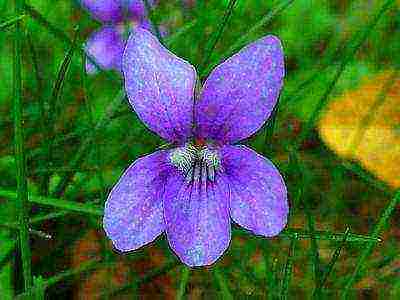
Using garden violets in home design
The garden violet, planting and caring for which is not difficult, is indispensable for use in the design of alpine gardens. On slides or flat rockeries, created of stone, it looks especially beautiful and graceful because of its small size, which is further emphasized by the rock.
In the garden, violets are also used to decorate ridges, flower beds and borders. These plants feel quite well among shrubs and trees, not far from water bodies. They are also suitable for growing in a variety of garden pots, containers and balcony boxes.All kinds of braids with these romantic flowers look very interesting.
Violets behave well in a limited amount of soil - in pots or pots. This plant is best for use in tiered stands and for creating small and large potted groups.
It is excellent to plant a fragrant violet near resting places or in front of windows in the front garden.
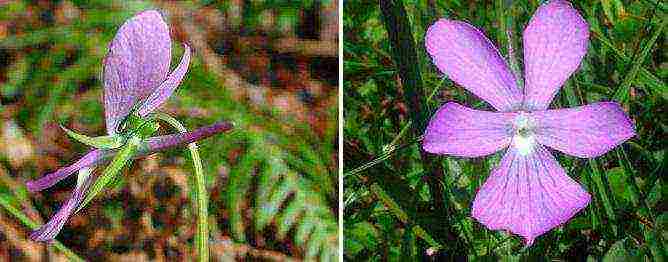
Garden violet in urban landscape
The perennial garden violet is actively used in the landscape of cities. Photos of flower beds with this plant are unusually picturesque.
Violets are rightfully classified as flowering herbaceous perennials, but their use in the design of urban ensembles is very limited. Mostly restrictions are imposed by their small size and rather short flowering time. This creates difficulties in the selection of partners and the placement of violets in the compositions.
For beauty and saturation, violets are always placed in groups or spots. The more significant arrays they are planted, the more decorativeness, aroma, and beauty of flowering are revealed.
This is one of the most peculiar plants for bordering flowering shrubs, rose bushes or the formation of landscape carpets, which gives picturesque and delicate beauty to the whole ensemble.
Violets are also good along the edges of flower beds or mixborders, where flowers are planted in the first line so that they can be seen. It is good if the period of their flowering coincides with the period of flowering of some plant that is planted in the depths of the flower garden.
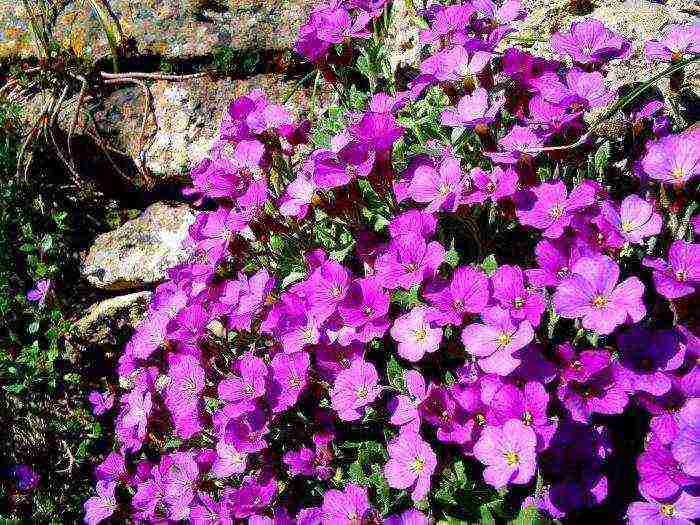
Planting and breeding violets
Regardless of the variety and species, perennial garden violets, the care and reproduction of which will not give you any special problems, disperse well by self-sowing. Manually, they are propagated by cuttings, sowing seeds or layering (dividing bushes):
- Cuttings are cut from May to June. Violet stems are divided into five-centimeter segments. Any such piece of the shoot should have three knots. All the flowers and some of the leaves (you need to leave three) are torn off, and the cuttings are tilted into a container with fertile moist soil by 1 cm.A month later, rooting will occur and the plant can be transplanted to a permanent place with a distance between the bushes of 10-30 cm.
- For layering, a long stem is chosen from the side and bent to the ground, reinforced with a hairpin and sprinkled with soil. After a month, the branch will take root and can be detached.
- Another method of reproduction - by dividing the bush - has a horned viola due to a special rhizome branching in all directions, from which young bushes grow. The common bush is dug up and divided into parts.
Sowing violet seeds
The garden perennial violet reproduces perfectly by seeds. Planting and caring for her begins in the fall. Fresh seeds are sown into the soil in September, and shoots appear next spring.
Sowing Vittrock violet seeds depends on the planting goals:
- To obtain annuals, seedlings are sown in early spring, when the temperature rises to +10 ° C. After sowing, the seeds are lightly crushed with soil and covered with foil. The sprouts will sprout in about a week. When the seedlings have at least four leaves, they are planted in a permanent place.
- For a two-year planting, seeds are sown in June on a raised plantation. They do not immediately sow on a flower bed, since it is not known how many seedlings there will be. If not all ascend, then there will be a "bald head". After a couple of weeks, sprouts hatch, after the appearance of two true leaves, the seedlings dive. At the end of summer, young plants are planted in a permanent place with a distance of 10-15 cm. They will bloom only next year, but the flowers will be larger and there will be more of them.
Violet care
In general, viola is an undemanding plant. But there are a number of conditions that must be taken into account when growing it.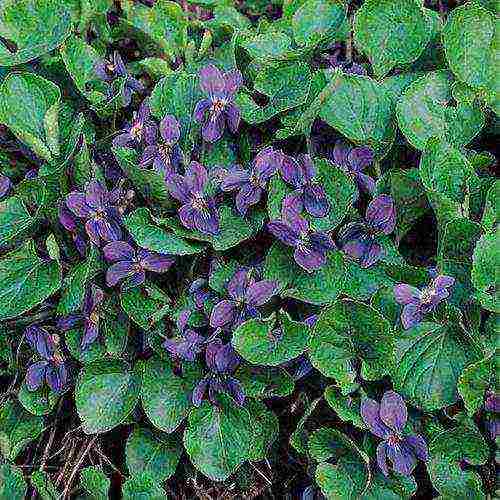
Violet desperately needs a sunny spot. But it is able to grow in partial shade, only its stems begin to stretch intensively and the bush loses its shape.
It is imperative to water this plant often: it adores moisture. But if the bed is arranged in a lowland, then you need to take care that there is no stagnation of water.
Every couple of weeks to feed the violets, you can use any mineral fertilizers for flowering plants, but avoid fresh organic ones: the viola has a bad reaction to them.
Flowers that wither should be systematically cut off, so the plant will caress the eye with flowering for a longer time.
In very hot weather, the stems of the viola grow intensively and the bush loses its decorative effect. In order to return the plant to a compact form, it must be cut. It is even worth cutting off the shoots with flowers. The stems should be about 8 cm long. After a couple of weeks, the viola will revive and will continue flowering again.
Garden violets do not like damp and cold winters. The planting should be easily covered with spruce branches or tree foliage.
Pests and diseases
Like any garden plant, the violet is susceptible to damage by diseases and pests. The main ones are:
- Powdery mildew affects stems, leaves and buds, spiderweb bloom and black dots appear. It is treated by spraying with antifungal agents.
- The leaves are affected by spotting, the plant dries up, the infection can persist even in the seeds. It is necessary to destroy and dig up the garden bed, treat it with chemistry.
- The stem base becomes thinner and darker. This is a black leg. The reason is that the crops are thickened, the illumination and moisture regime is violated. The bed must be loosened, thinned out and treated against fungus.
- The flowers are covered with gray rot - a fluffy bloom with decay. The reason is little light, a lot of moisture and nitrogen. Treatment consists of thinning, airing, fertilizing. Chemical treatment is also needed.
- In May-June, the plant is affected by the caterpillars of the clover moth and mother-of-pearl violet. It is necessary to spray with tobacco infusion and chlorophos when young caterpillars appear.

Garden violet - seemingly a typical forest dweller
Tiny violet stars, although unpretentious, are unlikely to be definitely "tame" flowers. This is partly why gardeners love them so much: the delicate perennial garden violet steadfastly retains the charm of a "forest" inhabitant and reminds of wild nature. The glades, where these pretty miniature flowers grow densely, give the impression of naturally occurring corners.
Classification of species
The ancient genus of violet-viola has more than four hundred species branches today. The culture is good because it blooms profusely and for a long time with minimal human participation. If no effort is made, the touching and fragrant garden violet will delight the owners with lush color only in spring. Later, the plant will "go into seeds" (covered with a decent number of bolls) and will lose its decorative effect.
For many, or rather young (usually grows only 3-4 years old) include, first of all, fragrant and horned violet. Among the "breeds" bred by the breeders, there are also those for which the name "pansies" is popularly stuck. They are large-leaved: the aggregate of petals in some cases forms a corolla 5-10 cm in diameter. Other "big-eyed" descendants remind their parent very distantly.
- The fragrant violet is small, incredibly fragrant. The smell "grows stronger" in the evening. Such a baby reaches only 15-18 cm in height, has a creeping stem. The spine is tenacious, easily held on the protrusions. The leaves are in the form of a heart, held in a bunch. The flowers are tiny (up to 3 cm), bluish or purple. There are simple and double varieties. Fresh seeds are needed for planting and successful germination.
- The horned viola is not much more impressive in size - about 8-25 cm "tall". The name is associated with the presence of a spur-like protrusion on the back of most sepals. The usual diameter of the corolla is 1.5-3.5 cm. The shade range is extensive - from blue-white-yellow to orange-red-black.The range of hybrid varieties is impressive, but they are more difficult to "winter" and, as a rule, belong to biennials.
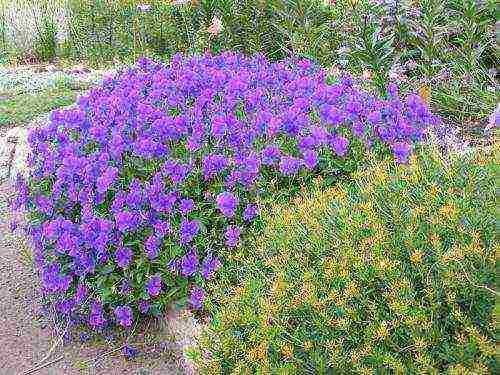
If you methodically pluck the boxes from the bushes, the violet will bloom profusely and for a long time.
There are few lovers of the snow-white beauty-violet, but in vain: she is very attractive in appearance and in the solid circle of her closest relatives there are many large individuals. As for the garden white violet as a species used in gardening, such a phrase is often referred to as conditional. The reason is a significant variety of representatives of the genus of violet light shades, identified with the word "white".
Among the white-leaved specimens there will be a klobuchkovaya ("blonde" with purple dots), individual members of the already described "slingshot" company and breeding varieties of fragrant relatives of the forest pale purple brotherhood. An Italian-Turkish Parma violet and a large terry Australian-American "white queen" will complement this noble family of snow white.
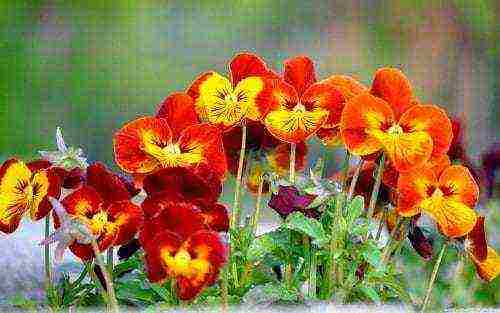
The spectrum of violet shades is wide and varied - red and black colors are relevant in it
Features of planting and reproduction
The best habitat for most varieties of the described flower is moderately sunny open areas of a flower garden or garden. Slightly shaded clearings with damp (but not too wet!) Loose soil are also a suitable environment for the growth of viola. Relative fertility is important for the land, moderation is important for irrigation. Feeding is desirable, a couple of times per season. In winter, it would be nice to cover the area with a layer of soft branches and foliage.
Of the methods for reproducing planting material, the main ones are growing from seeds, cuttings, dividing bushes. There are certain rules for planting and caring for perennial garden violets of different varieties. The most favorable period for seed reproduction (planting) is the transition from summer to autumn, in August-September. The seedlings will sprout next spring, so a cute blooming rug is guaranteed in May.
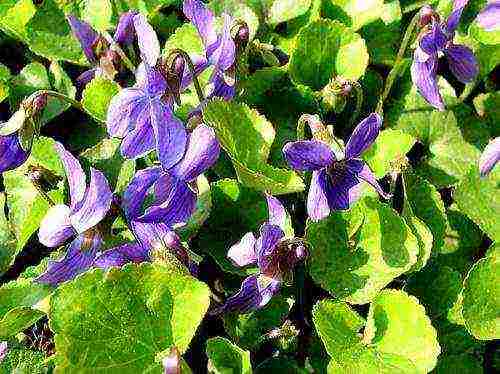
Fragrant violet - unpretentious perennial
Seed handling
Agrotechnical manipulations are not difficult, but some conditions will have to be met. The freshness of the seed is one of them. Sowing in grooves is accompanied by light mulching. Peat or humus is ideal for this process. A densely sown mass will need a pick, with a "step" of 5-7 cm. The beds are spilled with a solution in advance, and the seeds are powdered with fungicide so that the fungus does not appear.
If the seeds were bought in winter and were planted in boxes, they will need to be covered with foil or glass. Leaky. In a cool place (12-18 °), the plants overwinter successfully - in constantly moistened (but not damp!) Soil. Distillation is slow, from one to one and a half to two months. As soon as the seedlings "hatch", it is recommended to move the boxes to a warmer corner, with a temperature of 18-22 °.
Diving after the appearance of the first pair of true leaves is performed as needed, weeding, loosening the base and feeding - too. A complex, non-concentrated fertilizer solution is used. Pour it every 10-15 days. Note: the seeds sown in spring germinate almost twice as early as the "autumn" ones. Self-seeding is also acceptable for them, but ineffective.

Colored varieties of horned violets are pleasing to the eye
Planting seedlings in the ground
On the site set aside for the violet kingdom, seedling bushes cut from the ground with a formed root are planted at a distance of 30 centimeters, trying to provide a decent nutritional area for the plant. Flowering will begin about a month after the development of the leafy part. Undoubtedly, the violets left to winter on the insulated section of the lawn will bloom earlier.
Vegetative reproduction
It's about bush division and cuttings. The first rejuvenates the variety and prevents the degeneration of the variety. The second allows you to preserve and reproduce even a single copy.

There are hundreds of exotic varieties of violets today - they are used as garden and indoor flowers
Division of bushes
The chain of action "starts" in the spring, shortly before flowering, or in the summer, after flowering ends. Part of the bush is cut off - with a scoop or with a knife - and transplanted to a new site. Bush-making is applied to fragrant violets, moth, horned, two- and three-colored - tall and branched, often mottled with streaks and specks. Non-resistant hybrids such as Pansies are also planted in this way.
Before dismembering the curtain and planting fragments from the plant, remove the remnants of flowers. A bunch of stems with part of the roots is moved into the shade, into a moist (better drained) environment. It's easy to do after rain. It is not necessary to cover the "immigrant". He will take root anyway, proving that planting and caring for a garden violet is not burdensome. By autumn, the bush will bloom profusely, and by winter it will form a root system.

The modesty of the white moth violet gives it a touch of innocence and incredible charm.
Using cuttings
The most suitable time for green cuttings is from May to July. After the loss of bush compactness and crushing of the flowers (and these are common phenomena), the upper shoots with 2-3 nodules are cut off. Root them in two weeks. Engraftment is almost always successful - the group will bloom at the turn of summer and autumn. Later, cuttings will delay the appearance of color by six months - until May-June.
Thematic video
Tips for planting violets (video):
Attractive path spots with cute violets will perfectly fit into flower beds, mixed flower beds, rocky hills, lawns, curbs and "revive" empty meadows around trees. They are modest and not capricious, but they are unusually pretty and full of inner dignity. Carried away by these crumbs, you will noticeably ennoble the aura of your garden and home.
Fragrant violet is a herbaceous perennial plant that is found in deciduous forests. The flower prefers mountain slopes and glades, but it is also grown in garden plots.
Violet attracts with its small purple flowers and pleasant aroma. The plant blooms in April and again in late summer.
The violet has a powerful rhizome, giving many shoots, and a stem 15 cm long. The leaves are simple, rounded, located at the root rosette. The flowers are single, with 5 petals, the lower one is wider.
Cultural forms of the fragrant violet:
- Bechtles Ideal - a plant with large blue flowers;
- Coeur d'Alsace - decorative form with pink inflorescences;
- Queen Charlotte - a hybrid with large lilac flowers;
- Red Charm - perennial with lilac inflorescences and burgundy core, suitable for growing at home;
- Foxbrook Cream is a white violet with a yellowish core.
After flowering, the plant forms a spherical box with seeds. In nature, the violet reproduces by seeds. In the garden, propagate it by dividing the rhizome.
For planting, choose open, sunny or partially shaded areas. Provide the plant with good light in the morning and in partial shade during the day.
Violet prefers fertile, loose soil. Plant plants around the edges of your flower bed or under trees. At home, place them in containers, put them on a balcony or loggia.
Plant the seeds in open ground in the spring. In colder climates, get your seedlings at home first and transplant them into your garden bed in May.
Growing violets includes certain care:
- Watering. Water the plant regularly to keep the soil moist. In dry conditions, increase the intensity of watering.
- Top dressing. Before flowering, feed the perennial with a complex flower fertilizer.
- Protection from pests. In a drought, the flower is attacked by a spider mite. As a result, the leaves of the plant turn pale and dry out. Spray the underside of the leaves daily to control the pest.
After 3-4 years, replace the flowers in the flower bed.Remove old plants and plant new ones. Add compost and flower garden fertilizer to the soil. If you do not renew the planting, then the bushes grow, oppress each other and stop blooming.
Fragrant violet is a ground cover plant that can complement landscaping. The plant blooms profusely with constant watering and feeding.
A perennial horned violet is an unpretentious flower, but nevertheless, in order to successfully grow it in the garden, you need to know the features of care. You can also use this plant to create original landscape design compositions. Its attractive colors make it blend in with other flowering crops.
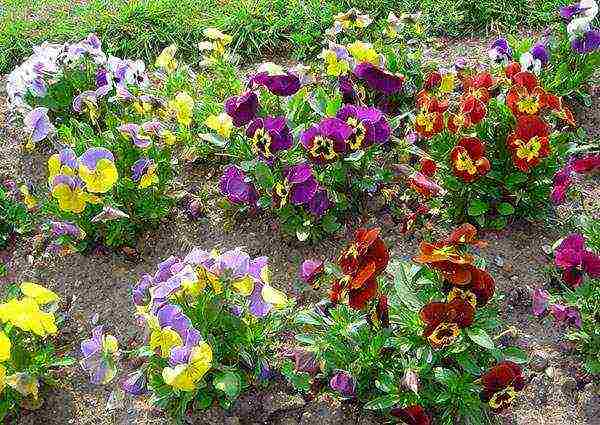
Brief description of the species
It is easy to distinguish a perennial violet (lat.Viola cornuta), since plants of this species have specific leaves. Their color is deep green, and their shape is ovoid with a pointed tip. Wild specimens reveal inflorescences in a characteristic color scheme - you can find purple, snow-white, bluish and lilac shades. The petals are always simple and medium-sized, the diameter of the corollas does not exceed 2-4 cm. The number of flowers on each bush reaches up to 60 pieces, which makes the violet look spectacular.
The height of the plant may vary - it all depends on the variety. There are both 8-centimeter and 25-centimeter specimens, which at first grow into small bushes, and over time turn into real flowering meadows. The ornamental beauty of the plant was discovered in 1776, and since then it has become a permanent resident of many gardens and parks.
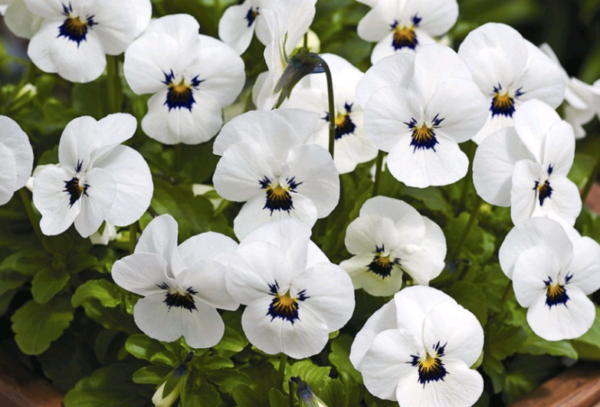
This type of violet received the name "horned" for a reason - all thanks to the process located behind the flower itself, which in shape is very reminiscent of a miniature horn.
Nowadays, many hybrids have been obtained from the wild-growing garden perennial violet, among which you can find large-flowered specimens of a wide variety of color shades. The plant fell in love with flower growers due to its decorative appearance and long flowering. The garden violet begins to bloom after the snow melts, reaches its peak in the middle of the summer season and pleases until the very first frosts.
How to grow a perennial garden violet
To grow a fragrant beauty violet in your garden, you need to follow some recommendations that relate to the selection of a growing place, soil composition and lighting:
- Optimal landing place - in diffused shade, where there is no direct exposure to sunlight, but a sufficient amount of light. It is best if the violet is slightly shaded by higher plants, branches of trees or bushes, especially in the first time after planting in the ground;
- Costs avoid partial shade or shade, since the sun's rays are a prerequisite for the abundant flowering of garden violets. In addition, they provide protection against slugs;
- Perfect soil - slightly acidic, light and well-drained. You can achieve such a composition by digging up a site for a future planting in the autumn and adding humus to it. You can also add superphosphate, calculating the required amount of fertilizer based on the indicators on the package. In the spring, re-digging is carried out, the soil is leveled and large lumps of earth are broken;
- Violet likes good humidity, but without stagnant water. In order for the soil to be constantly moistened, it is necessary to mulch it by adding gravel, moss, and tree bark.
It is possible to grow a horned perennial violet from seeds and in a vegetative way (through dividing a bush or by cuttings).
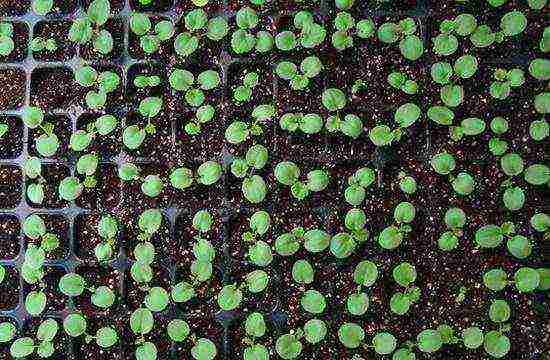 Sowing seeds of horned violet (viola)
Sowing seeds of horned violet (viola)
Sowing seeds
You can get seedlings of perennial violets using seeds. Sowing is carried out according to the following scheme:
- It is necessary to purchase fresh high-quality seeds, thereby guaranteeing good germination of crops.
- Seeds are sown in shallow grooves, before that it is recommended to add a small amount of peat to the ground ("by eye").
- To prevent the occurrence of fungus, you need to "dust" the seeds with any available fungicide (Strobi, Agat-25K, Skor, Quadris) and also spill the soil with a solution (the dosage for the solution is indicated by the manufacturer on the package).
- After a couple of true leaves have appeared on the plant, you need to dive, providing the seedlings with the necessary free space for development.
- It is necessary to dive seedlings in such a way that there is a distance of about 5-7 cm between neighboring plants.
- When weeds appear, it is necessary to weed the beds. It is also recommended to periodically loosen them, giving access to air.
 Fungicides for seed treatment
Fungicides for seed treatment
When to sow seeds
You can sow the seeds of a perennial garden violet in both autumn and spring. However, here it is worth considering the fact that "autumn" ones germinate 2 times longer. Planting seedlings in a permanent place of growth is carried out after the root system is formed. The distance between the bushes should be about 30 cm. After the ground part of the flower has developed, after about a month you can wait for flowering.
Cuttings
Horned violet also propagates by cuttings. Cutting allows you to get several new bushes from one bush of a horned violet, thereby multiplying the variety you like. This breeding method is pretty simple:
- Optimal timing of - from May to July.
- It is recommended to moisten and loosen the selected landing site, opening access to air.
- As cuttings are taken green shootsthat grow from above. The number of sheets on each copy should be at least two.
- Planting cuttings is carried out to a depth of 1.5-2 cm to the prepared bed.
- In order for the planting material to take root in the soil faster, you can cover the plantings with a damp cloth or transparent film, thereby creating a greenhouse environment.
- When weeds appear, it is recommended to weed the bed, also monitor the soil moisture, if necessary, watering and spraying the plants.

Dividing the bush
It is optimal to propagate the garden fragrant violet by dividing the bush if the grower wants to rejuvenate the plant and prevent the degeneration of the variety. The work is carried out in several stages:
- The time to divide is before or after flowering.
- All flowers and their remains are removed from the plant.
- A part of the overgrown bush (fragments with roots) is cut off with a sharp scoop or knife and transplanted to a new place.
- Ideally, the separated plant will grow in well-drained soil, in light shade.
- In the spring, after the first wintering, the plant is planted in a permanent place.
Caring for a horned violet in the garden
A perennial violet does not require careful maintenance - periodic weeding, watering, fertilizing and maintaining a decorative appearance are enough.

How to water
The horned violet, although it loves moist soil, does not like excessive watering, so it should be carried out without fanaticism. If the weather is hot, it is worth focusing on the speed of drying of the soil and shedding the beds as necessary. However, this does not mean that the plant will not be able to survive the forced drought - it may well wait for you to return from vacation or the next weekend.
Prolonged drought negatively affects the appearance of the horned violet - the growth of the bushes slows down, and the flowers become much smaller and lose their original attractiveness. That is why it is still not recommended to experiment with the lack of watering in the heat, but to moisten the soil well. This garden flower reacts very well to spraying - if the temperature is high in summer, it is recommended to pamper the plant with a “shower” 2 times a day, in the morning and in the evening.
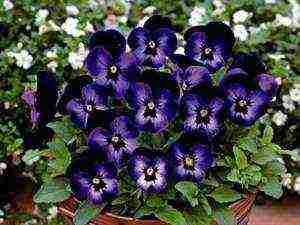
Top dressing - when, how and how much
The right time to apply top dressing to the soil is the active spring growth of the plant in the spring and the second half of August.In this case, you can use any mineral or organic fertilizers for flowering plants that are sold in a specialized store. The recommended concentration rate is low, therefore always apply to the soil in 2-3 times less feeding than indicated on the packaging by the manufacturer.
The only exception as fertilizer is fresh manure, which can harm the garden horned violet instead of benefit. It aggressively affects the root system of the plant, burning it and causing the death of the entire flower.
Maintaining the decorative appearance of the bush
Compact and well-groomed garden perennial violets can lose their attractiveness over time, stretching the stems in length and becoming, as it were, unkempt. To restore the beauty of the bushes, flower growers recommend a "haircut", forming plants of the desired shape and size. In this case, you need to cut the stems to a height of 8 cm.
Removing dried and wilted flowers allows the plant not to waste energy on the formation and maturation of seeds, but directing them to abundant and rich flowering.
Horned violet in landscape design
Perennial violet is successfully used by flower growers to decorate ridges, borders and flower beds. This flower can significantly diversify the flower garden and fill the empty space around trees and bushes. Quite spectacular are group plantings of plants, which, during the opening of the buds, seem to "capture" all the free space. The flower looks original against the background of coniferous bushes and trees, and also perfectly coexists with roses.
A horned violet looks attractive on alpine slides and flat stone rockeries. The contrast of the composition is achieved due to the small size of the graceful flowers. You can also plant a plant near water bodies, artificial waterfalls and ponds. For this, violets of bright colors are often used, which noticeably "enliven" the landscape.
